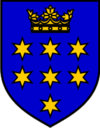Rešetari
| Rešetari | ||
|
||
|
|
||
| Basic data | ||
|---|---|---|
| State : |
|
|
| County : |
|
|
| Area : | 53 km² | |
| Residents : | 4,753 (2011) | |
| Population density : | 90 inhabitants per km² | |
| Telephone code : | (+385) 035 | |
| Postal code : | 35 403 | |
| License plate : | NG | |
| Structure and administration (status: 2013, cf. ) |
||
| Community type : | local community | |
| Structure : | Adžamovci, Brdjani, Bukovica, Dreznik, Gunjavci, Rešetari, Zapolje | |
| Mayor : | Zlatko Aga ( HSLS ) | |
| Postal address : | Ulica Vladimira Nazora 30 35403 Rešetari |
|
| Website : | ||
| Others | ||
| Patron saint : | Krist Kralj | |
Rešetari is a municipality in Croatia with 4,753 inhabitants (2011 census). Rešetari is located in the west of the Brod-Posavina County, in the south-west of Slavonia and borders the town of Nova Gradiška . The Rešetari municipality has an area of 59.42 km² and thus 2.93% of the total area of the county. The village itself and the villages Adžamovci, Brđani, Bukovica, Drežnik, Gunjavci and Zapolje belong to the municipality.
geography
The municipality is geographically very favorable and is connected to the A3 motorway and the Zagreb - Vinkovci railway line . A well-developed network of national roads enables good connections to Osijek and Požega. The municipality is located about 130 km east of the Croatian capital Zagreb, 30 km south of Požega and about 15 km north of the border with Bosnia and Herzegovina .
societies
In Rešetari there are parishes in the villages of Zapolje and Rešetari. There are also elementary schools in Adzamovci and Rešetari. There are several clubs active in the community, namely two cultural clubs, several sports clubs and three volunteer fire departments . The cultural association "Rešetari", through the association of the Croatian diaspora (Matica Hrvatskih Iseljenika), maintains good relations with the associations of Croatian abroad and performs regularly abroad.
economy
The main carriers of economic activities in Rešetari municipality are small and medium-sized enterprises, traders, traders, transport companies and farmers. Rešetari has about 5500 hectares of agricultural land.
The municipality's budget in 2008 was 9,732,060.00 kunas , which corresponds to an amount of 1,331,335.00 euros.
population
The first mention of the place is dated to 1407. After the breakthrough of the Ottomans (1533–1536), the Croatian population fled west. At the same time, the Muslim and Serbian population of northern Bosnia invaded the abandoned villages. After the Ottomans withdrew, the Muslim population fled and Serbs and Croats from Bosnia were settled. At the end of the 19th century and with the construction of the railway, there was a wave of colonization from German-speaking countries, the Czech Republic and Hungary, as well as from the Croatian provinces of Gorski Kotar, Lika and Zagorje. After the Second World War (1941–1945) the German-speaking population was expelled, and settlers came from other regions of Croatia. After the outbreak of the War of Independence in 1991, there were again large population movements and very many Serbs left the country.
The 2011 census shows that 98.42% are Croatians and only 1.58% are from the following minorities: Serbs, Italians, Albanians, Montenegrins, Hungarians and Ukrainians.
history
There are no written traces from the time of the great migrations in the 6th century and the settlement of the Croats on today's national territory, so that the first documents date from the late Middle Ages. In the historical sources Rešetari is mentioned for the first time in 1407 in the list of villages in the Požega valley. At that time the place was called Resetarowich Villa. The name villa meant that the village had a church. This was the Catholic Church of John the Baptist. The most famous ruling family was that of the Zapoljski. The manor stretched between Rešetari and Vrbje. The Croatian-Hungarian King Ivan Zapolja (1527–1540) / dt also comes from this family . Johann Zápolya . After the Ottoman sultan Suleyman the Magnificent came to power, the conquest of Slavonia began in 1521. After the defeat of the Christian armies at Mohács, years of Turkish occupation and oppression followed. Only after the defeat of the Ottoman army near Vienna (1683) did the liberation of Rešetari begin. It was not until 1691 that the Turks could be displaced to Bosnia via the Save. After that, the whole region will gradually recover, both demographically and economically. After the liberation of Slavonia, important reforms were carried out to prevent a renewed occupation by the Ottomans. This is how the military border is established. In 1740 the construction of the new administrative center of the military border west of Rešetari began. Later the garrison became the town of Nova Gradiška. During the First and Second World Wars, Rešetari was largely spared from the war. During the Croatian War (1991-1995) the place and the community were repeatedly attacked by the air force and artillery of the Yugoslav People's Army . Many residents served in the Croatian army and contributed to the fact that the place was not occupied.
literature
- 175 godina skole u Rešetarima , Zagreb 2006

